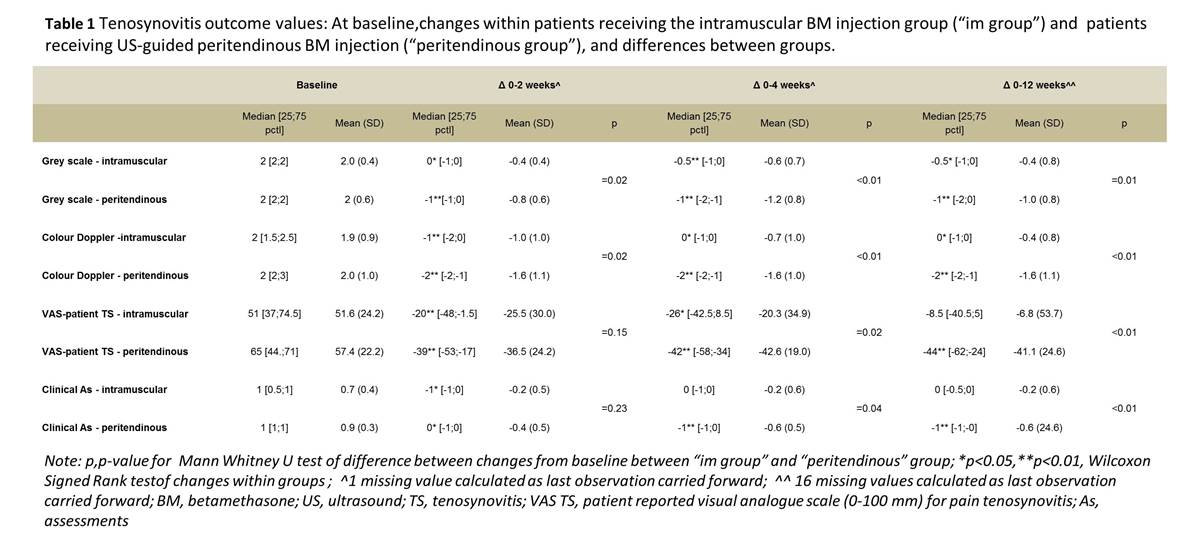Session Information
Date: Monday, November 14, 2016
Title: Imaging of Rheumatic Diseases II: Ultrasound in Rheumatoid Arthritis
Session Type: ACR Concurrent Abstract Session
Session Time: 2:30PM-4:00PM
Background/Purpose:
The aim of this study was to compare the efficacy of intramuscular versus ultrasound (US)-guided peritendinous glucocorticoid injection in providing disease control after 2, 4 and 12 weeks in rheumatoid arthritis(RA) patients with tenosynovitis.Methods:
Fifty RA patients with tenosynovitis were randomised into two double-blind groups: A. “intramuscular group”, receiving intramuscular injection of betamethasone and US-guided peritendinous isotonic saline injection and B. “peritendinous group” receiving saline intramuscularly and US-guided peritendinous betamethasone injection. All patients were in stable disease-modifying anti-rheumatic drug treatment prior to and during the study. Patients were excluded, and considered non-responders, if any treatments were altered during the follow-up period. “US tenosynovitis remission”, defined as US tenosynovitis grey-scale score ≤1 and colour Doppler score=0, was assessed at week 4 (primary outcome), and weeks 2 and 12, using non-responder imputation for missing data. The tenosynovitis was assessed at baseline, 2, 4 and 12 weeks using the semi-quantitative scoring system for GS (0-3) and CD(0-3) as proposed by the OMERACT US group, clinical assessment and a patient reported pain tenosynovitis visual analogue scale (VAS tenosynovitis) from 0-100Results:
US tenosynovitis remission at week 4 was achieved in 25% (6/24) [95% confidence limits: 8%; 42%] in the “intramuscular group”, versus 64% (16/25) [45%; 83%] in the “peritendinous group” (Fisher exact test; p<0.01). Corresponding values for the “intramuscular group” versus the “peritendinous group” at 2 and 12 weeks were 21% [5%; 37%] versus 48% [28%; 68%] (p=0.07) and 8% (0%; 19%) versus 44% (24%; 63%) (p<0.01). Most US and clinical/patient-reported scores improved more in the “peritendinous group” at all follow up visits (see table 1).Conclusion:
In this randomised double-blind clinical trial, RA patients with tenosynovitis responded significantly better to US guided peritendinous glucocorticoid injection than to intramuscular glucocorticoid injection, both at 4 and 12 weeks follow up.
Disclosure: M. Ammitzbøll-Danielsen, None; M. Ostergaard, Abbvie, BMS, Boehringer-Ingelheim, Eli Lilly, Janssen, Merck, Pfizer, Roche, UCB, Celgene, Sanofi, Regeneron, Novartis, 2; V. Fana, None; D. Glinatsi, None; U. M. Døhn, None; L. M. Ørnbjerg, None; E. Naredo, None; L. Terslev, None.
To cite this abstract in AMA style:
Ammitzbøll-Danielsen M, Ostergaard M, Fana V, Glinatsi D, Døhn UM, Ørnbjerg LM, Naredo E, Terslev L. Intramuscular Versus Ultrasound Guided Peritendinous Glucocorticoid Injection for Tenosynovitis in Patients with Rheumatoid Arthritis – a Randomised, Double-Blind, Controlled Study [abstract]. Arthritis Rheumatol. 2016; 68 (suppl 10). https://acrabstracts.org/abstract/intramuscular-versus-ultrasound-guided-peritendinous-glucocorticoid-injection-for-tenosynovitis-in-patients-with-rheumatoid-arthritis-a-randomised-double-blind-controlled-study/. Accessed .« Back to 2016 ACR/ARHP Annual Meeting
ACR Meeting Abstracts - https://acrabstracts.org/abstract/intramuscular-versus-ultrasound-guided-peritendinous-glucocorticoid-injection-for-tenosynovitis-in-patients-with-rheumatoid-arthritis-a-randomised-double-blind-controlled-study/

